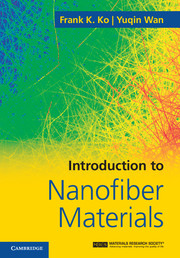Nanofiber-forming technology
There are a number of techniques capable of fabricating nanofibers. These techniques include conjugate spinning, chemical vapor deposition, drawing, template synthesis, self-assembly, meltblown and electrospinning.
Conjugate spinning (island in the sea)
Sea–island-type conjugate spinning involves extruding two polymer components from one spinning die. The fiber islands are arranged in a sea component which is later removed by extraction. Nakata et al. reported that continuous PET nanofibers with a diameter of 39 nm could be obtained by sea–island-type conjugate spinning from the flow-drawn fiber with further drawing and removal of the sea component. Figure 3.1 shows a TEM image of a PET fiber island and Nylon-6 sea produced by conjugate spinning and flow-drawing [1].
Chemical vapor deposition (CVD)
In a CVD process, a substrate is exposed to one or more volatile precursors, which react and/or decompose on the substrate surface. The desired deposit is synthesized on the substrate surface. The volatile by-products are produced during the process and are removed by gas flow through the reaction chamber. The various forms of material that can be produced via CVD include monocrystalline, polycrystalline, amorphous, and epitaxial. Some examples of such CVD-fabricated materials are silicon, carbon fiber, carbon nanofibers, filaments and carbon nanotubes [2]. Figure 3.2 shows a schematic illustration of a plasma-enhanced CVD setup that can be used for fabricating single-walled carbon nanotubes.
